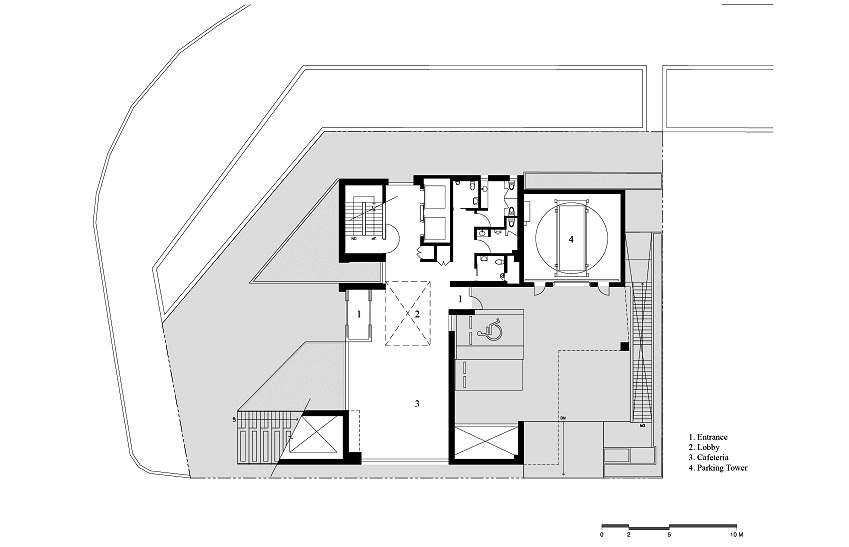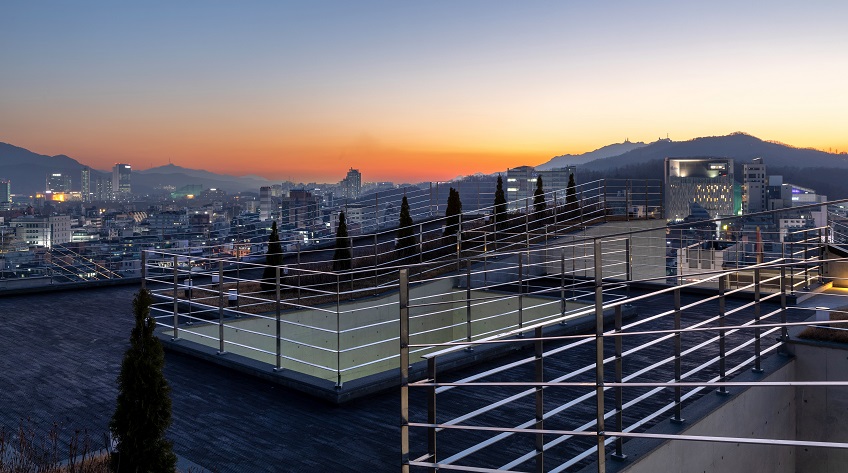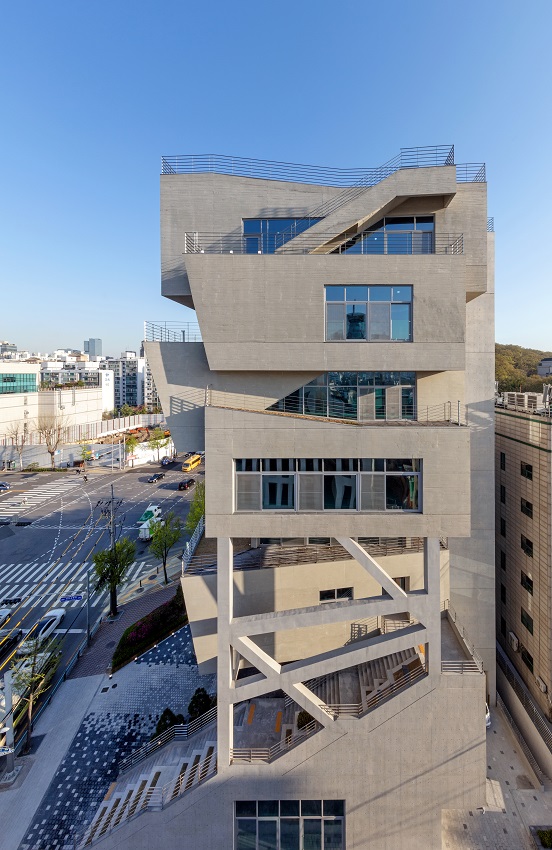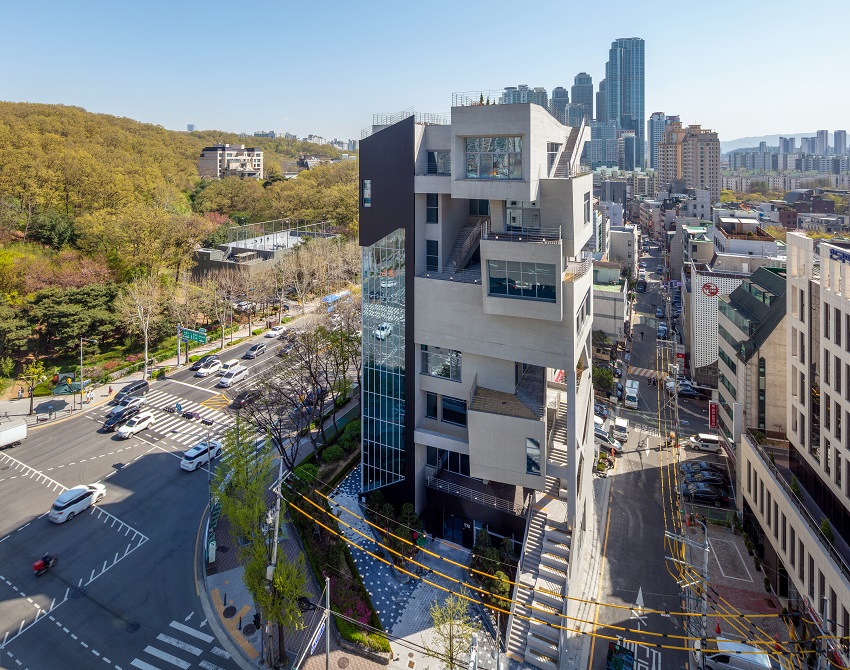In the year 2014, D_Werker Architects was established by two very talented Korean architects – Hwon Yoon and Jieun Lee in Seoul. In the last 8 plus years, the innovative duo has established their names in the world of architecture with amazing body of works.
Jieun Lee has been an ardent individual since her early childhood. Her love towards paintings, sculpture, poetry and physics amalgamated Jieun Lee towards architecture as she grew up. She loves to be immersed in her creative endeavours. During her stint in Germany, Jieun Lee was a registered architect with the Chambers of Architects, Berlin – ArchitektenKammer Berlin. She is a registered architect with KIRA – Korea Institute of Registered Architects.

Jieun Lee talks to Johnny D at great length about her journey in the architectural field and their award-winning project ‘EMK Musical Company’ in Seoul.
When you look back at your childhood ambition, did you always wanted to be an architect? How has been your journey so far?
In my childhood, I was very interested in physics, poetry/novel, painting, sculpture, etc. As I grew up, I realized architecture was an integrated field of my interests. So, my experience in architectural design became accumulated. I experienced the areas of painting and sculpture go hand-in-hand with architecture.
My interest in architecture has grown more in terms of not only thinking about various fields comprehensively, but also creating a space that contains human life. Accordingly, I wanted to have a more academic and diverse experience. So I continued my quest after graduation. I went to Germany for further studies.

Please share how Hwon Yoon and you joined hands to establish D_Werker Architects?
Hwon Yoon and I had been working independently until we went to Berlin in 2009. Occasionally, we had a project or two to work on together. In the beginning, having two different individualistic views, it was difficult for us to reach to an agreement on architectural design(s). However, as we spent more time together in Berlin, we both realized that two views are better than one (smiles). The understanding grew into a strong bonding. In the year 2013, we returned back to our homeland. In 2014, we established D_Werker Architects in Seoul.

When the client states the brief to you in the first meeting, what really goes in your mind?
Most clients talk about objective data, such as the size, program, budget and so forth of the building they want. But we want to obtain information about the more fundamental reason that the client hopes to realize in the structure, as well as these objective data. So, we try to extract as many stories as possible, including personal matters, with the building owner, through which we intend to understand the meaning hidden behind the project. It is not only because it could become a key to the design and set the direction for the project to proceed, but also because we think that it is the responsibility of the architect who should realize the space that the client dreams of.

What was the brief of the ‘EMK Musical Company’ project?
EMK Musical Company suggested a methodology for constructing a small-to-medium-sized office building. They wanted the upper and lower parts of the building to be divided and utilized, by allowing the lower floors to be used as rental areas and simultaneously open to the public and the upper floors to be used like another site that has a private external area as a company building, through the ‘strategy of’ outside space floating in the air’.

How would you describe the ‘EMK Musical Company’ project from an architect’s perspective?
The site’s location played a significant role in designing the project by creating unique urban landscapes from various perspectives – the freely arranged architectural elements will not only form the identity of EMK Musical Company, but also act as beings that give fresh changes to the urban landscape. I hope that the building will become a symbolic being of the growth of EMK Musical Company.
The practice room and office of the musical – which has the largest volume among the programs – are arranged on the basement and the 5th floor. The upper part of each volume becomes an external space, each of which comes to have an independent external space. Particularly, the outer space on the 1st floor, which is inevitably lost by giving the lower floors of the office building as a rental space, becomes replaced with a courtyard external space on the upper floors to acquire a spatial specificity.

The column structure that connects and supports the two programs will become the ‘Main Structure’ of the entire building. It also becomes the base, where the rest of the programs can be freely placed. In addition, the external spaces created by freely placing the rental and office areas on the upper parts of the two external spaces will be filled with various programs, such as open-air cafés, open-air offices, and outdoor conference rooms.

What were the major challenges you foresee from the planning stage to the execution of ‘EMK Musical’ project on the real grounds?
The ‘EMK Musical’ project was designed differently for the form of each floor, while pursuing the diversity of space. These slightly complex forms required precise and detailed planning not only in architectural design, but also in the construction phase. Thus, we had to constantly discuss with each partner, as well as structural engineers and construction engineers, from the initial design phase to the completion of the building.

How did your team overcome them creatively as the project progressed?
The musical practice room on the basement floor and the EMK’s office space on the 5th floor required a large space compared to the size of the site. To solve this problem, we identified through geological investigation on precise construction technology and variables that might occur during the construction stage – for example, underground rock – and also discussed design and construction methods with engineers.
The limited budget and the COVID – 19 situation were the biggest challenge! Supply of materials and rising prices of raw materials played their own tricks during the construction phase. So, we had to have constant dialogue and consultation with the client and construction team.

How would you describe the ‘Elegance of Design’ of the project?
I think for us, the ‘Elegance of Design’ is about finding the identity of each project. To this end, we are endeavoring to design a space and form that fits the purpose and characteristics of each project. The ‘EMK Musical’ building is the first musical company building to be built in Korea. In this aspect, we intended to express the musical culture into an architectural space and form, beyond meeting the function of the building as a creative work space for a musical company.

Each mass protruding towards the road became a diverse musical stage. The internal and external spaces that connect them horizontally and vertically were organized, through which we tried to express a lively musical stage. Among the architectural elements, the stairs are inevitably the most familiar being to users who produce Musicals. This is because, considering the characteristics of musical producers whose thought flows are directed towards the audience, their gaze is always fixed on a step-shaped structure.

Please mention major ‘Sustainability’ features you incorporated in the project.
First of all, we intended to reduce the energy consumption of the building from environmental and economic point of view. We used a sliding window that could be connected with the outside space and the courtyard, which was designed into a window system that allows the user to directly control its opening and closing. Rainwater harvesting was incorporated. Water is and used for landscaping and cleaning.
To be sustainable from the social and cultural aspects, we planned to make a part of this building a place of culture to communicate with the local community. The open space at the main entrance on the first floor of the building and the stairs passing through the 1st and the 3rd floors were designed to be open to the public, so that it could become a place for people to sit and relax or an auditorium of the musical space on the day of an external performance.
Furthermore, the upper courtyard and roof garden, which were made by arranging a large-volume mass on the 5th floor, and the external stairs connecting them, were planned as a protected space ‘only for employees’ of the ‘EMK Musical’ company.

Briefly explain the conscientious efforts of the civil / structural engineers in this amazing project?
In designing a building, which has its own individuality in the form, the structural design idea occupies an important part in the overall construction plan. In most projects, we contrive and plan both the construction plan and the structural plan at the same time, allowing structural engineers to participate in deciding structural systems from the initial design phase. In addition, even at the construction phase, we are working hard to find the best construction method so that the planned ideas can be realized, by discussing and negotiating with structural engineers and construction engineers in the site.

What is the total area of the project, estimated cost and time period of the project – design-to-finish?
The total area of the project is 2,898.82 sq. m. The cost of the project is estimated to be $9.2 million. The project was started in 2018 and completed in 2021.
What are the various projects your firm is currently busy with, in various cities and countries?
Currently, we are working on projects regarding business, housing, resorts and the like in various areas of Korea, including Seoul, the metropolitan area, and Jeju-do.

Please state five recent awards won by D_Werker Architects.
– 2021: 10th Gangnam Beautiful Architecture – Top Prize for ‘EMK Musical Company’;
– 2017: American Architecture Prize – Honorable Mention for ‘Unicity’;
– 2017: Korean Architecture Award – Excellence Award for ‘Unicity’;
– 2016: Gyeonggi Architectural Culture Festival – Bronze Prize for ‘Silentium’;
– 2014: Anyang Architectural Culture Festival – Silver Prize for ‘Silentium’.
Image Courtesy: D_Werker Architects
Photographer: Inwoo Yeo